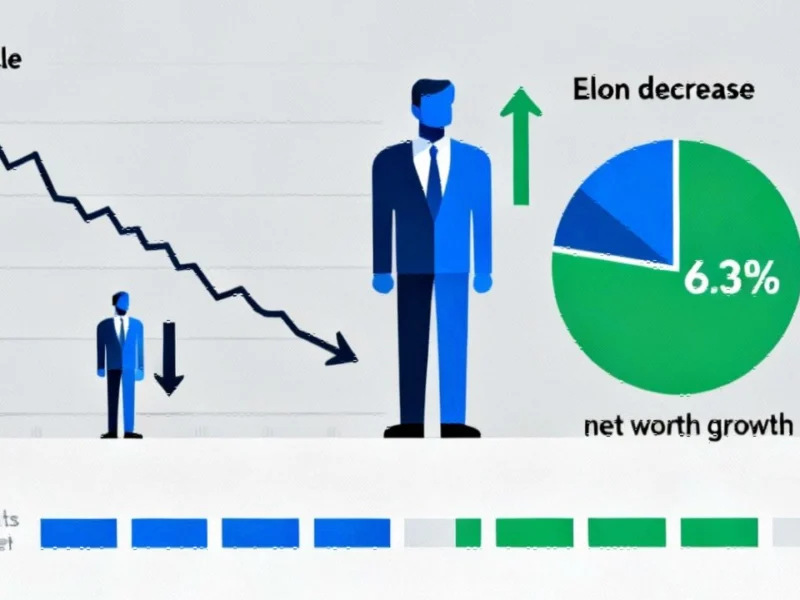Note: Featured image is for illustrative purposes only and does not represent any specific product, service, or entity mentioned in this article.
Executive Silence on Spending Plans Triggers Oracle Stock Retreat
Oracle shares experienced significant volatility this week as investors reacted to the company’s lack of detailed capital expenditure guidance, despite overwhelmingly positive revenue projections. The stock decline erased approximately $24.1 billion from Chairman Larry Ellison’s net worth, though he maintains his position as the world’s second-wealthiest individual with an estimated $350.6 billion fortune.
According to recent financial analysis, the absence of forward-looking commentary on expenditure plans during recent executive briefings created uncertainty among investors. Jefferies analyst Brent Thill noted that while Oracle executives provided ambitious revenue targets, they failed to elaborate on how capital investments would align with their aggressive growth strategy.
Analysts Maintain Bullish Outlook Despite Market Reaction
Interestingly, the market’s negative response hasn’t dampened analyst enthusiasm for Oracle’s long-term prospects. Thill raised his price target for Oracle’s stock to $400 from previous estimates of $360, while other prominent analysts followed suit with similar adjustments. This divergence between short-term market reaction and analyst confidence highlights the complex dynamics shaping current technology investment trends.
Stifel analyst Brad Reback maintained a more conservative $350 price target, suggesting that while Oracle’s growth narrative remains compelling, execution risks persist. The varying analyst perspectives reflect broader debates about how to value companies in the rapidly evolving cloud infrastructure sector.
Unprecedented AI-Driven Growth Projections
Oracle’s staggering revenue forecasts have captured industry attention, with the company projecting cloud infrastructure revenue to reach $18 billion this fiscal year before nearly doubling to $32 billion in 2027. Even more remarkable are the subsequent projections: $73 billion, $114 billion and $144 billion over the following three years.
The company’s contracted revenue—money promised but not yet recognized—surged 359% to $455 billion, driven by four multibillion-dollar contracts with three different customers in the latest quarter. These figures suggest Oracle is positioning itself as a major contender in the cloud infrastructure race, potentially challenging established leaders through aggressive strategic partnerships and AI integration.
The Ellison Wealth Rollercoaster
Larry Ellison’s net worth has experienced dramatic fluctuations in recent months, reflecting Oracle’s volatile stock performance. Last month, Oracle shares recorded their largest single-day gain since 1992, adding $110 billion to Ellison’s fortune and briefly making him only the second person to surpass the $400 billion wealth threshold.
The recent $24 billion decline represents a 6.3% decrease in his net worth, though he remains significantly ahead of other tech billionaires. Ellison continues to trail Elon Musk, whose fortune has rebounded to approximately $485.9 billion as Tesla’s valuation recovers. This wealth volatility underscores how technology sector developments can rapidly reshape billionaire rankings.
Industry Context and Competitive Landscape
Oracle’s ambitious growth projections come amid intensifying competition in the cloud infrastructure market. The company’s strategy appears focused on leveraging artificial intelligence demand to capture market share from established players. However, competitors aren’t standing still, with major players making significant AI integration advancements across their product ecosystems.
Deutsche Bank analyst Brad Zelnick captured the sentiment of many industry observers when he described Oracle’s projections as creating “a shock in a very, very good way,” suggesting the company’s announcements represent “no better evidence of a seismic shift happening in computing.”
Market Implications and Future Outlook
The disconnect between Oracle’s bullish revenue forecasts and the market’s reaction to its capital expenditure ambiguity raises important questions about how investors value growth versus execution clarity. While the company’s AI-driven strategy appears compelling, the lack of detailed spending plans has introduced uncertainty about how Oracle will achieve its ambitious targets.
As the cloud infrastructure market continues to evolve, Oracle’s ability to balance aggressive growth with transparent communication will likely determine whether it can maintain investor confidence while executing on its vision to become a dominant force in the next generation of enterprise computing.
This article aggregates information from publicly available sources. All trademarks and copyrights belong to their respective owners.



